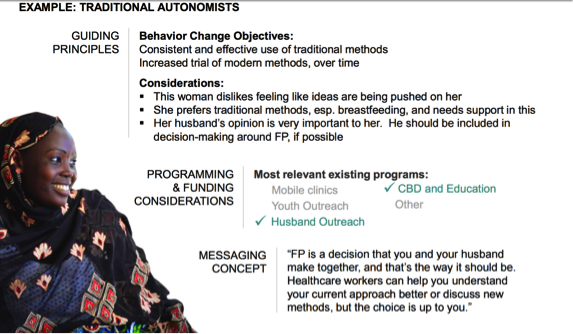After information has been gathered about the different audience types, summarize the audiences into broad categories. To identify each audience category, consider one key criterion that distinguishes these groups. The example below describes potential audience categories for a family planning intervention. Each category is described using one distinguishing characteristic that makes it relevant using a ‘because they’ statement.
Women
Because they do not access family planning due to a fear of side effects.
Men
Because they control financial decisions in the household and don't understand benefits of family planning.
Policymakers
Because there is no budget at the national level for family planning commodities.
Health Care Providers
Because they believe young unmarried women should not access family planning.
The next step is to identify audience “segments” within each broad category. Segments are smaller groups of individuals with similar characteristics. Because people respond differently to SBCC messages and interventions, segmentation focuses service communication efforts, allowing implementers to hone messages and use the most appropriate channels.
Review the information from your completed Audience Characteristics and Behavioral Factors Template, looking for smaller groups with similar behaviors to identify smaller groups with similar behaviors, needs, values and/or characteristics from the larger audience. For example, the exercise will reveal similarities among female health providers who work in rural areas or urban males aged 15–19.
Audience segmentation should first identify the criteria for dividing the larger audience. This requires studying the audience and identifying the traits that different sub-groups share. A significant difference is one that requires a different message or approach and could be defined by socio-demographic, geographic, behavioral and/or psychographic characteristics. For example, men who are the intended audience for a family planning intervention are a larger audience category but within that group are a number of segments which might be defined by: age (i.e., 25-44); marital status; location (i.e., men living in urban or rural settings); education (i.e., men with a secondary education); stage of readiness (i.e., men who may be more ready to adopt FP because they have heard of family planning or are not limited by cultural norms). Analyzing the data will help to understand which of these criteria distinguishes one group from the others.
Based on what you found during your review of the Audience Characteristics and Behavioral Factors Template, identify potential segments using the Segmentation Table. The table below provides some examples of characteristics that could help identify smaller audience segments.
Examples of Audience Segments:
| Audience | Potential Segments |
|---|---|
| Women of reproductive age |
|
| Adolescents |
|
| Male youth |
|
| Health providers in rural areas |
|
Use this checklist to determine whether a group represents a distinct audience segment:
Download Checklist to Assess Proposed Segments
Source: Health Communication Capacity Collaborative – How to Do Audience Segmentation
In Niger, the Camber Collective conducted audience research that led to innovative audience segmentation for family planning programming. Given the need for behavior change, they used attitudinal and behavioral variables rather than traditional demographic and psychographic variables to segment the audience. Specifically, they looked at use behaviors, proactivity, social norms, contraceptive specific behaviors, and attitudes and beliefs. Using these key variables led to the creation of five distinct segments: Modern Elites, Healthy Proactives, Traditional Autonomists, Conservative Passives, and Sheltered Skeptics.
These segments were used to design distinct behavioral objectives, messages, benefit statements, and materials for each group.
Source: Camber Collective’s ICFP Presentation, January 2016
Read more about the research and the segmentation process.






